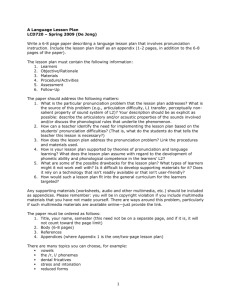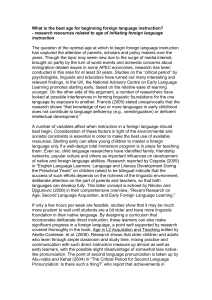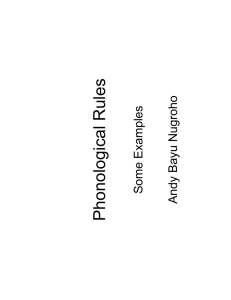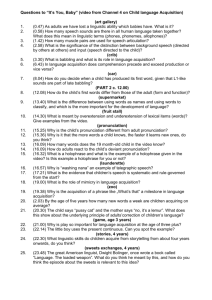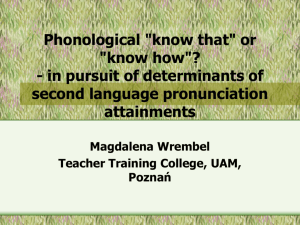Metacompetence-oriented model of phonological acquisition: implications for the teaching and learning
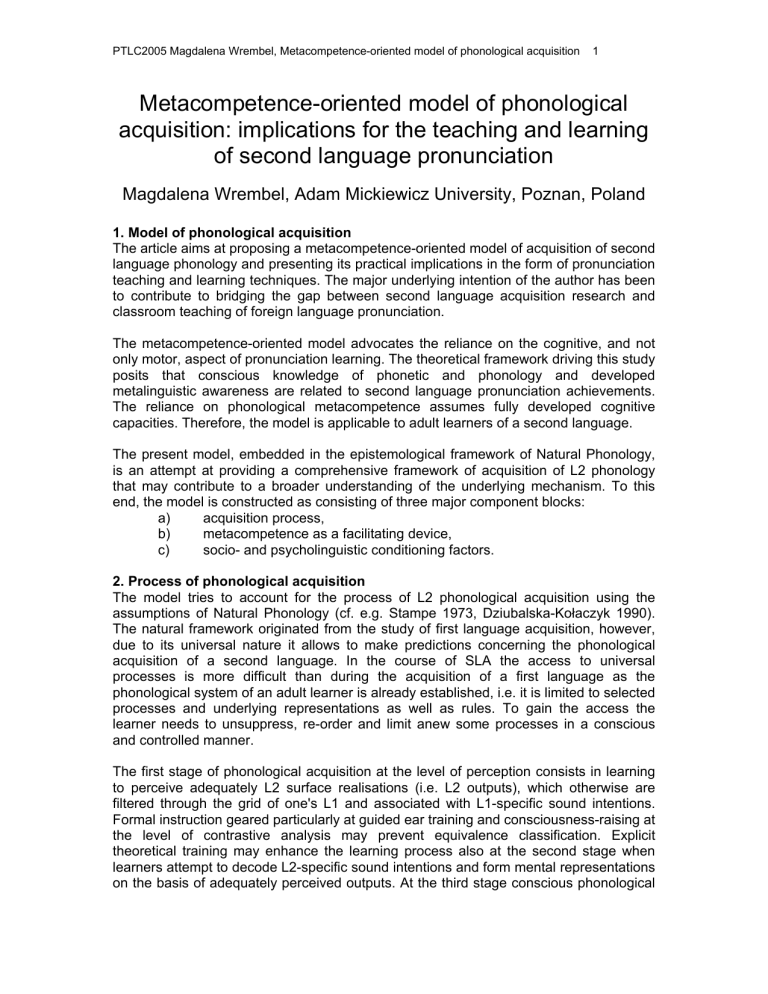
PTLC2005 Magdalena Wrembel, Metacompetence-oriented model of phonological acquisition 1
Metacompetence-oriented model of phonological acquisition: implications for the teaching and learning of second language pronunciation
Magdalena Wrembel, Adam Mickiewicz University, Poznan, Poland
1. Model of phonological acquisition
The article aims at proposing a metacompetence-oriented model of acquisition of second language phonology and presenting its practical implications in the form of pronunciation teaching and learning techniques. The major underlying intention of the author has been to contribute to bridging the gap between second language acquisition research and classroom teaching of foreign language pronunciation.
The metacompetence-oriented model advocates the reliance on the cognitive, and not only motor, aspect of pronunciation learning. The theoretical framework driving this study posits that conscious knowledge of phonetic and phonology and developed metalinguistic awareness are related to second language pronunciation achievements.
The reliance on phonological metacompetence assumes fully developed cognitive capacities. Therefore, the model is applicable to adult learners of a second language.
The present model, embedded in the epistemological framework of Natural Phonology, is an attempt at providing a comprehensive framework of acquisition of L2 phonology that may contribute to a broader understanding of the underlying mechanism. To this end, the model is constructed as consisting of three major component blocks: a) acquisition process, b) c) metacompetence as a facilitating device, socio- and psycholinguistic conditioning factors.
2. Process of phonological acquisition
The model tries to account for the process of L2 phonological acquisition using the assumptions of Natural Phonology (cf. e.g. Stampe 1973, Dziubalska-Kołaczyk 1990).
The natural framework originated from the study of first language acquisition, however, due to its universal nature it allows to make predictions concerning the phonological acquisition of a second language. In the course of SLA the access to universal processes is more difficult than during the acquisition of a first language as the phonological system of an adult learner is already established, i.e. it is limited to selected processes and underlying representations as well as rules. To gain the access the learner needs to unsuppress, re-order and limit anew some processes in a conscious and controlled manner.
The first stage of phonological acquisition at the level of perception consists in learning to perceive adequately L2 surface realisations (i.e. L2 outputs), which otherwise are filtered through the grid of one's L1 and associated with L1-specific sound intentions.
Formal instruction geared particularly at guided ear training and consciousness-raising at the level of contrastive analysis may prevent equivalence classification. Explicit theoretical training may enhance the learning process also at the second stage when learners attempt to decode L2-specific sound intentions and form mental representations on the basis of adequately perceived outputs. At the third stage conscious phonological
PTLC2005 Magdalena Wrembel, Metacompetence-oriented model of phonological acquisition 2 knowledge helps learners to associate inputs with outputs and to work out phonological processes operating in L2. This, in turn, leads to reactivation of universal processes and to a complete recovery of L2-specific universal preferences. Finally, perception feeds into production and conscious knowledge of articulation assists learner's phonetic performance acting as a monitoring device and offering the possibility of reflective feedback.
3. Phonological metacompetence
The core construct of the model is phonological metacompetence, which is understood as conscious knowledge of and about the grammar of the language and which may be developed by making the learner metalinguistically aware of L2 phonetics and phonology.
The notion of metacompetence alludes to the distinction in cognitive psychology between 'declarative knowledge' and 'procedural knowledge' that has been recently applied to SLA. Broadly speaking, declarative linguistic knowledge refers to speaker's knowledge of linguistic facts, whereas procedural knowledge refers to know-how in using the language.
Phonological metacompetence is postulated as a major facilitating device capable of enhancing the process of acquisition in a threefold manner as:
1) facilitator of intake - operating at the level of perception and helping input to become conscious intake through formal explicit instruction and guided ear training,
2) acquisition facilitator - forming adequate representations and preventing the mapping into L1 system owing to the conscious analysis of the underlying process,
3) monitoring device - providing reflective feedback on the production by equipping L2 learners with necessary tools for self-monitoring and self-correction as well as promoting conscious awareness of the influencing potential of socio-and psychological factors.
In an attempt to provide a broad and reliable acquisition framework, the model aims at accounting for an array of socio- and psycholinguistic factors that condition, to a large extent, phonological acquisition of a second language. Following Gardner's Socio-
Educational Model (1988), the present approach allows for the impact of the social milieu and individual learner's differences featuring motivation, intelligence and attitude. Apart from cognitive and sociolinguistic variables the model tries to account also for psychological and affective factors as well as oral and auditory capacities. The proposed metacompetence-oriented model promotes conscious awareness of the influencing potential of extralinguistic factors with a view to exercising some control over learner variables and fostering attitudes conducive to success at pronunciation learning.
4. Suggested pronunciation teaching techniques
The model entails practical recommendations for the construction of L2 pronunciation teaching methodologies and points to specific techniques for the development of phonological metacompetence. The scope of the proposed techniques is multifarious ranging from alternative and innovative methods integrating cognitive, affective and psycho-motor aspects of pronunciation learning to more mainstream activities involving conscious analysis of theoretical linguistic knowledge. The former include general awareness-raising techniques incorporating extra- and para-linguistic elements such as gestures, mimicry or relaxation in order to foster conscious control of articulators and perceptual tuning-in. The latter correspond to more elaborate practices that often rely on advanced technologies providing a new range of feedback and presentation modes.
PTLC2005 Magdalena Wrembel, Metacompetence-oriented model of phonological acquisition 3
The schematic presentation of suggested techniques (see Table 1) is based on different degrees of explicitness, on the one hand, and elaboration, on the other.
B Articulatory control
Articulatory warm-up exercises
Drama voice techniques:
Articulatory setting exercises:
* voice quality
* imitation and oral mimicry
Mnemonic devices
* anchoring sound patterns
A Basic awareness-raising
Relaxation, breathing, visualisation
Sensitisation:
* perceptual tuning-in
Awareness raising activities:
* discussions
* questionnaires
* metaphonetic trivia
* concern for pronunciation
* pronunciation and identity
D Multimedia learning aids
Animated views of the articulators
Video close-ups of the mouth
Computerised displays of speech
Palatograms
Spectrograms
Self-monitoring techniques
C Informed teaching techniques
Theoretical foundations (rules)
Contrastive information
Articulatory descriptions
Sound classification tables, vowel charts
Charts of the vocal apparatus
Snapshots of lips position
Pitch-contour notation
Guided ear-training - analytic listening
Transcription practice
Elaborate phonemic charts
Explicitness (covert - overt)
Table 1.
Metacompetence developing techniques
The present proposal assumes that the initial stages of conscious pronunciation teaching/learning should focus on building awareness and concern for pronunciation as well as adopting a favourable frame of mind and preparing the articulatory and auditory apparatus for the forthcoming practice (see Section A ). Awareness raising techniques involve investigating the general nature of pronunciation through e.g. developing physical awareness of word stress, walking the rhythm, internalising intonation through recognising moods and acting out tales, exploring physical features of sounds as well as personalising sounds through movements, sound metaphors and similes. Various materials can be used in order to boost L2 learners' phonetic awareness and intuition including, among others, metaphonetic trivia such as advertising leaflets, billboards,
SMS and Internet-lore in which some aspects of phonetics come to the fore mainly through puns. Another step to facilitate an accurate production of sounds in the second language and improve voice quality involves conscious relaxation of the muscles of the articulatory apparatus and assuming an appropriate frame of mind, which can be achieved by means of breathing exercises, relaxation or visualisation.
Section B enumerates metacompetence developing techniques based on articulatory control that involve a higher degree of elaboration, though they are still not fully explicit in providing declarative knowledge of the phonetic system of the target language. Such practices involve voice modulation techniques typically used by drama coaches and articulatory warm-up exercises that aim at a greater articulatory agility and, consequently, a more native-like performance. These techniques of metalinguistic and extralinguistic awareness raising aim at regaining conscious control over the process of articulation through pre-speech physical preparation including, among others, postural alignment,
PTLC2005 Magdalena Wrembel, Metacompetence-oriented model of phonological acquisition 4 muscular tension release and warming, vocal work-out, massaging face and jaw muscles, lip and tongue activation as well as warming the voice and releasing resonance.
A further aspect of phonological metacompetence is related to developing a more authentically native-like 'voice quality' or 'setting', which can be achieved through a conscious attempt at an adaptation of a long-term articulatory posture specific for a particular target language, i.e. a characteristic pitch level, vowel space, tongue position and the degree of muscular activity.
Section C represents more mainstream explicit pronunciation teaching activities referred to as informed teaching techniques . Contrary to some opinions restricting pronunciation training to imparting motor and auditory skills, the present approach attaches a paramount importance to the cognitive aspect of phonological acquisition.
Metacompetence-oriented theoretical training in the sound system of the target language assumes conscious knowledge of rules and detailed articulatory descriptions to facilitate the production of particular sounds. Such techniques endorse an analytic-linguistic approach to pronunciation pedagogy adopted from the Reform Movement and include e.g. articulatory diagrams with head cross-sections accompanied by a detailed description and a visual presentation of the actual articulatory movements. Conscious training of auditory skills may take various forms ranging from simple discrimination and identification tasks to more elaborate guided ear-training. The model endorses also appeals to learners' different modalities through multisensory means of presentation and practice using visual, kinaesthetic and tactile reinforcements.
Finally, section D offers the highest level of elaboration and explicitness as far as phonological metacompetence enhancement techniques are concerned. The majority of techniques suggested therein rely on multimedia learning aids and advanced technologies. As the oral speech mechanism is readily accessible to direct observation, some computer assisted instructional programs or web pages offer animated views of the articulators during speech or vocal folds in motion as an additional visual support for the conscious analysis of the articulatory process. Another option is to video tape learners' faces during speech production and subsequently examine such close-up frames of articulators in order to determine whether a particular sound was produced in a target-like manner or to analyse the overall articulatory posture, i.e. overall muscular tension in the supralaryngeal tract or the position of the larynx. A modern method of registering tongue movements is palatography or electropalatography, which demonstrates the extent of the contact area between the tongue and the roof of the mouth. The perception and production of foreign sounds may be reinforced by a conscious analysis of the acoustic spectrum displayed in the form of a spectrogram.
Furthermore, more advanced pronunciation teaching courses available on CD-ROMs offer instant audio-visual feedback in the form of computerised displays of speech patterns allowing to record learners' utterances and compare a visual display of intonation contours with pre-recorded native-speaker models.
The present metacompetence-oriented framework strives to empower learners by equipping them with self-monitoring strategies so that they may be involved consciously in the speech modification process. In practice, it entails helping L2 learners to develop self-rehearsal techniques (e.g. talking to oneself, audio- or videotaping presentations or rehearsing in small groups) as well as providing them with concrete self-study guidelines and procedures for self-diagnosis.
PTLC2005 Magdalena Wrembel, Metacompetence-oriented model of phonological acquisition 5
5. References
Dziubalska-Kołaczyk, Katarzyna (1990) A Theory of Second Language Acquisition within the Framework of Natural Phonology. Poznań: AMU Press.
Gardner, Robert (1988) The Socio-Educational Model of Second-Language Learning:
Assumptions, Findings, and Issues. Language Learning, 38, 101-127.
Stampe, David (1973) 1979. A Dissertation on Natural Phonology.
Bloomington: IULC.

